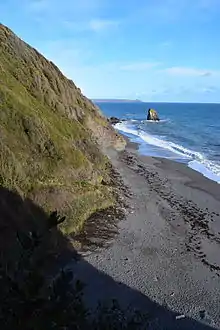Downderry
| |
|---|---|
 Downderry Location within Cornwall | |
| OS grid reference | SX315540 |
| Civil parish | |
| Unitary authority | |
| Ceremonial county | |
| Region | |
| Country | England |
| Sovereign state | United Kingdom |
| Post town | TORPOINT |
| Postcode district | PL11 |
| Dialling code | 01503 |
| Police | Devon and Cornwall |
| Fire | Cornwall |
| Ambulance | South Western |
| UK Parliament | |

Downderry (Cornish: Downderri) is a coastal village in southeast Cornwall, England, United Kingdom. It is situated 12 miles (19 km) west of Plymouth and one mile east of Seaton.[1]
Downderry has a long beach of light shingle. There is road access down to the beach via a slipway although this is blocked by a locked gate, pedestrian access is still possible. Dogs are allowed on the beach. The beach further east is a nudist beach.[lower-alpha 1][2]
The village and beach offer views of Looe Island to the west and Rame Head to the east and on clear days the Eddystone Lighthouse 8 miles (13 km) offshore.
The village has a Church of England church, a Methodist chapel, a shop with a post office, a pub, a restaurant, a coffee shop and a primary school.
The Church of St Nicolas Downderry began as a mission church to service the growing population of the village. The building dates from the late 19th century.
Points of interest
Bass rock
Approximately 700 metres (770 yd) east of the village center is a rocky outcrop known locally as "Bass Rock", this is a popular fishing spot as it affords access to deeper water.
Coleadon
300 metres (330 yd) further on from Bass Rock are the cliffs of Coleadon, the promontory past these cliffs means access to the beach past this point is cut off at high tide.
The Long Stone (Shag Rock)

Past Coleadon is a 600 metres (660 yd) stretch of beach which ends in a rocky outcrop known locally as "Shag Rock" after the seabirds who can be seen sitting on the rock drying their wings after diving for fish. This marks the end of easy foot access to the coastline. There is a path up the cliff which leads to the road above this beach, the climb is pleasant but reasonably strenuous. The ruins of an old Victorian lodge, known as "St Germans Hut", can be found halfway up this cliff path.
Television transmitter
On one of the hills above the village is a television transmitter which serves as a repeater for the local area.[3][4]
Chain Home bunkers
During the Second World War Downderry was the site of a Chain Home radar installation. The remains of this installation are present and can be found on the East side of the village. One of the bunkers has been converted into a residential garage, the other is no longer accessible from the road as it is now private property.[5]
Neolithic earthworks
The only known example of a 'cursus' earthwork in Cornwall is situated behind the village in the fields near Triffle farm.[6]
Wreck of the Gipsy
.jpg.webp)
The wreck of the Gipsy can be found just off of Downderry in about 7 metres (23 ft) of water 90 metres (300 ft) west of the slipway. Originally named 'The Rodney' she was an iron full-rigged ship built in 1874 by W. Pile & Co., Sunderland.
In Nov. 1895, Rodney lost her figurehead in a gale in the English Channel, while en route from Gravesend, Kent to Sydney. The figurehead washed ashore at Whitsand Bay, Cornwall, six months later.
In 1897, the ship was sold to F. Boissière, of Nantes, France, and renamed Gipsy (the cross-over year, per Lloyd's, is 1896/97). Re-rigged then as a Barque. On Dec. 7, 1901, the vessel was wrecked, a total loss, at Downderry on the return voyage from Iquique (Chile) to France with a cargo of nitrate. The 1,447 tonnes (1,424 long tons; 1,595 short tons) ship lost her bearings and became stranded on the reef. She was blown apart by explosives as she had become a hazard to local fishing vessels. Parts of the wreck are strewn over a large area in about 7 to 8 metres (23 to 26 ft) of water.[7][8]
Artistic impression
Downderry! Downderry! The very name of this small Cornish seaside village has a rhythmic, lyrical quality... Downderry down, Downderry down... it rings of lymeric, folk song and rhyme. Snug between the bay of Whitsand and the promontory of Looe, Downderry with its spouse Seaton, bathes in the constant ebb and flow of the English Channel. Their gentle cliffs roll and tumble towards the sea.
References
- ↑ Location of naturist beach near Downderry 50°21′37″N 4°20′29″W / 50.360174°N 4.341492°W
- ↑ Ordnance Survey: Landranger map sheet 201 Plymouth & Launceston ISBN 978-0-319-23146-3
- ↑ Lewis, Simon. "Downderry Beach Information". Cornwall Beach Guide. Retrieved 22 July 2016.
- ↑ "FreeTV Transmitters". Ukfree.tv. Retrieved 24 December 2015.
- ↑ "Downderry TV transmitter info". Fmscan.org. Retrieved 24 December 2015.
- ↑ "Flying Past - The Historic Environment of Cornwall: Ground Defence". Historic-cornwall.org.uk. Retrieved 24 December 2015.
- ↑ "Flying Past - The Historic Environment of Cornwall: Heaven and Earth". Historic-cornwall.org.uk. Retrieved 24 December 2015.
- ↑ "The Sunderland Site Page 095". Searlecanada.org. Retrieved 24 December 2015.
- ↑ "Famous Ships". Ship Modelers Association. Retrieved 24 December 2015.
External links
![]() Media related to Downderry at Wikimedia Commons
Media related to Downderry at Wikimedia Commons